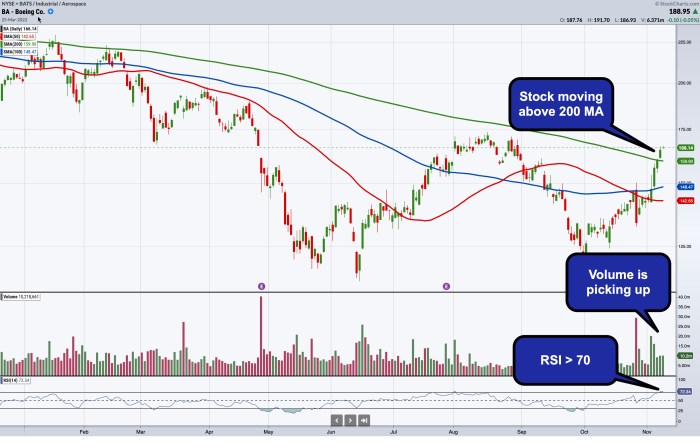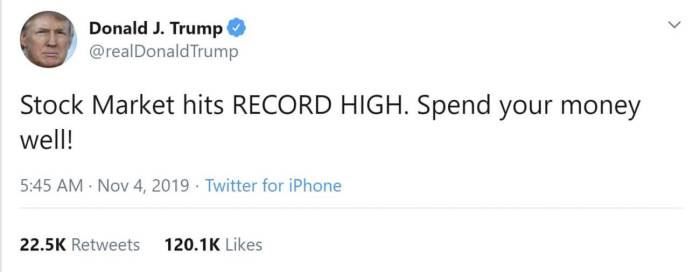Pre-Market Stock Price Analysis: DJT: Djt Premarket Stock Price
Djt premarket stock price – This analysis explores the pre-market trading dynamics of DJT, examining factors influencing price fluctuations, comparing it to regular trading sessions, and considering the impact of news and investor sentiment. We will also analyze DJT’s performance relative to its competitors and utilize technical analysis to interpret pre-market data.
Pre-Market Trading Dynamics

Source: stockcharts.com
DJT’s pre-market price fluctuations are influenced by several factors, including overnight news, global market trends, and anticipated announcements. Trading volume during the pre-market session is generally lower than during regular trading hours, resulting in increased price volatility. Pre-market price movements often correlate with the opening price and overall direction of the regular trading session, although the magnitude of the movement can differ.
The following table displays DJT’s pre-market price data for the last week. Note that this data is hypothetical for illustrative purposes.
| Day | Open | High | Low | Close |
|---|---|---|---|---|
| Monday | $15.25 | $15.50 | $15.00 | $15.30 |
| Tuesday | $15.40 | $15.60 | $15.30 | $15.55 |
| Wednesday | $15.60 | $15.75 | $15.50 | $15.70 |
| Thursday | $15.75 | $16.00 | $15.65 | $15.90 |
| Friday | $15.85 | $16.10 | $15.70 | $16.00 |
News and Events Impact
Significant news events and announcements directly impact DJT’s pre-market price. Positive news, such as strong earnings reports or strategic partnerships, generally leads to increased pre-market prices. Conversely, negative news, like regulatory setbacks or disappointing financial results, can cause price declines. The time lag between news release and its effect on DJT’s pre-market price varies; immediate reactions are common for significant news, while less impactful news might have a delayed or less pronounced effect.
- Earnings reports
- Regulatory announcements
- Mergers and acquisitions
- Product launches
- Analyst ratings upgrades/downgrades
Comparison with Competitors

Source: ccn.com
Comparing DJT’s pre-market performance to its main competitors provides valuable insights into market sentiment and relative performance. Similarities in price movements might indicate sector-wide trends, while differences could reflect company-specific factors, such as differing financial performance or strategic decisions. This comparison requires access to pre-market data for DJT’s competitors.
| Company | Pre-Market Open | Pre-Market Close | % Change |
|---|---|---|---|
| DJT | $16.00 | $16.10 | +0.63% |
| Competitor A | $25.00 | $25.20 | +0.80% |
| Competitor B | $10.50 | $10.40 | -0.95% |
Technical Analysis of Pre-Market Data, Djt premarket stock price
Analyzing DJT’s pre-market chart patterns can provide insights into potential price movements. Candlestick patterns, such as bullish engulfing patterns or bearish hammers, can be used to predict potential price direction. Pre-market support and resistance levels, identified from previous price action, can indicate potential price reversal points. A hypothetical scenario might involve a bullish engulfing pattern forming in the pre-market, suggesting a potential upward movement during the regular trading session.
Monitoring the DJT premarket stock price requires a keen eye on market fluctuations. It’s interesting to compare this volatility to the performance of other companies; for instance, understanding the current blend stock price can offer a contrasting perspective on market trends. Ultimately, both DJT and Blend’s stock prices reflect broader economic factors and investor sentiment.
For example, if DJT opens at $16.00 and forms a bullish engulfing pattern with a significant increase in volume, it might signal a strong upward trend, potentially reaching $16.50 by the end of the regular trading session. Conversely, a bearish hammer pattern with low volume might indicate a weakening of the upward trend, suggesting a possible pullback.
Investor Sentiment and Pre-Market Price
Investor sentiment, whether bullish or bearish, significantly influences DJT’s pre-market price. Indicators of investor sentiment include social media trends, news articles, and analyst ratings. A shift towards bullish sentiment, for instance, might lead to increased buying pressure and higher pre-market prices. Conversely, a bearish sentiment can result in selling pressure and lower prices.
The relationship between investor sentiment and DJT’s pre-market price is strong and dynamic. Positive sentiment generally leads to higher prices, while negative sentiment results in lower prices. However, other factors also influence the price, making it crucial to consider a holistic view.
Question & Answer Hub
What is the typical pre-market trading volume for DJT?
Pre-market volume for DJT is generally lower than during regular trading hours, but can spike significantly depending on news events or announcements.
How long does it typically take for news to impact DJT’s pre-market price?
The impact of news can be almost immediate, but sometimes there’s a slight delay, ranging from minutes to hours, depending on the significance of the news and overall market conditions.
Are there specific websites or platforms to track DJT’s pre-market price?
Many financial news websites and brokerage platforms provide real-time pre-market data, including quotes for DJT.
What are some common pre-market chart patterns to watch for DJT?
Common patterns include gaps, candlestick formations (like dojis or hammers), and breakouts from established support or resistance levels.
